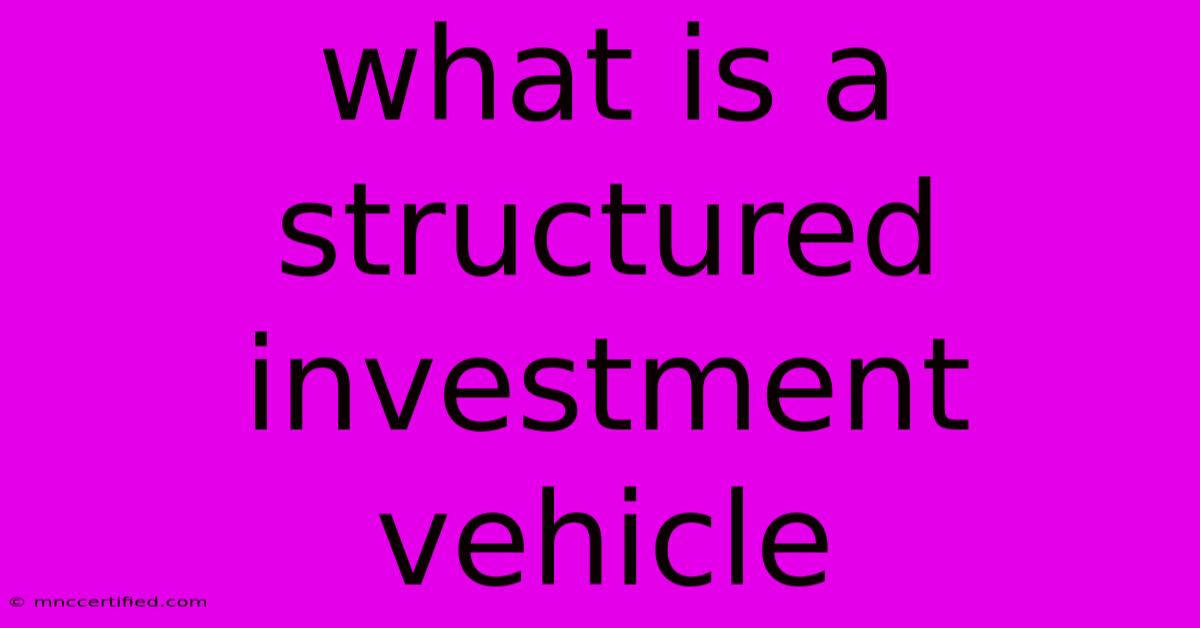What Is A Structured Investment Vehicle

Table of Contents
What is a Structured Investment Vehicle (SIV)?
A Structured Investment Vehicle (SIV) is a complex financial instrument designed to generate returns for investors by investing in a variety of assets, often structured as collateralized debt obligations (CDOs). SIVs typically borrow funds at short-term rates and invest in longer-term, higher-yielding assets, generating profits from the difference in interest rates.
Here's a breakdown of the key features and characteristics of an SIV:
Understanding the Structure
- Short-Term Funding: SIVs rely on short-term funding sources like commercial paper or asset-backed commercial paper (ABCP) to finance their investments. This means they need to constantly refinance their debt, making them vulnerable to market fluctuations.
- Long-Term Investments: SIVs typically invest in longer-term assets, such as mortgages, corporate bonds, or other asset-backed securities. This mismatch between short-term funding and long-term investments creates potential risks.
- Leverage: SIVs often employ leverage, using borrowed funds to amplify their returns. However, this leverage also magnifies losses in the event of market downturns.
- Special Purpose Entity (SPE): SIVs are usually set up as special purpose entities (SPEs), separate legal entities created for specific investment purposes. This separation helps to insulate the sponsoring financial institution from potential losses.
How SIVs Work
- Issuance of Commercial Paper: An SIV issues short-term commercial paper to raise funds.
- Investment in Assets: The SIV uses these funds to invest in a portfolio of long-term assets like mortgages, bonds, or other securities.
- Interest Rate Spread: The SIV aims to generate profits from the difference between the interest it earns on its investments and the interest it pays on its short-term borrowings.
Benefits and Risks of SIVs
Potential Benefits:
- Higher Returns: The potential for higher returns is a key attraction of SIVs, as they leverage and invest in assets that may provide higher yields.
- Diversification: SIVs can diversify investment portfolios by investing in a wide range of assets, potentially reducing overall risk.
- Liquidity: Some SIVs offer liquidity through their commercial paper, allowing investors to access their investments more easily.
Potential Risks:
- Interest Rate Risk: Changes in interest rates can significantly impact the profitability of SIVs, especially when funding is short-term and investments are long-term.
- Credit Risk: The value of SIV investments is susceptible to credit risk, meaning the risk that borrowers may default on their obligations.
- Liquidity Risk: SIVs can face liquidity risk if they struggle to refinance their debt in a tight market, potentially leading to defaults.
- Market Risk: SIVs are exposed to market risk, as the value of their investments can fluctuate based on overall market conditions.
The Role of SIVs in the Financial Crisis
SIVs played a significant role in the financial crisis of 2008. During the crisis, the value of their investments plummeted, primarily due to the housing market crash. This led to liquidity issues as investors lost confidence and SIVs struggled to refinance their debt.
Key Takeaways
- SIVs are complex financial instruments that can provide higher potential returns but also carry significant risks.
- Understanding the structure, benefits, and risks of SIVs is crucial for investors considering these instruments.
- The financial crisis highlighted the vulnerabilities of SIVs to market downturns and credit risks.
- Investors should carefully evaluate their risk tolerance and investment goals before investing in any complex financial product like an SIV.
Disclaimer: This article is intended for informational purposes only and should not be considered investment advice. Investing in complex financial products carries significant risks. Consult with a qualified financial advisor before making any investment decisions.

Thank you for visiting our website wich cover about What Is A Structured Investment Vehicle. We hope the information provided has been useful to you. Feel free to contact us if you have any questions or need further assistance. See you next time and dont miss to bookmark.
Featured Posts
-
Piedmont Hospital And Humana Insurance
Nov 09, 2024
-
Paris Olympics Award Horses Military Medals
Nov 09, 2024
-
Insurance Regulatory Examiners Society
Nov 09, 2024
-
The Dog Stars Ridley Scott And Paul Mescal Team Up
Nov 09, 2024
-
Who Accepts Paramount Dental Insurance
Nov 09, 2024